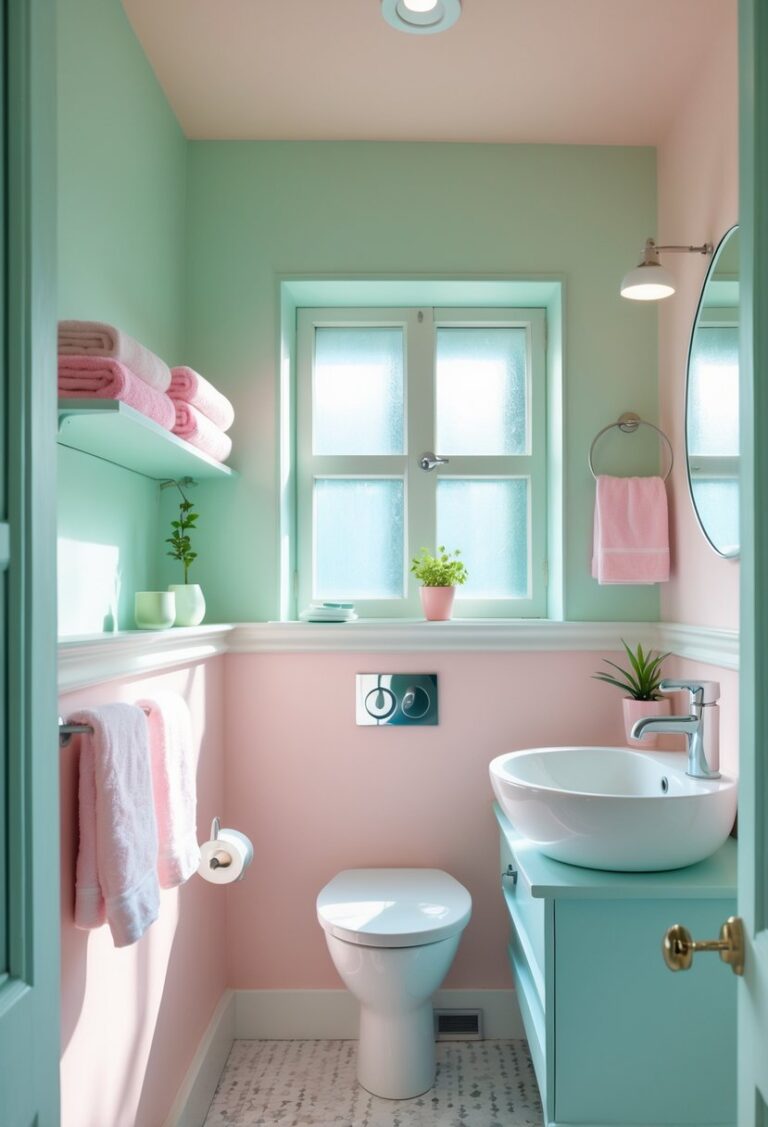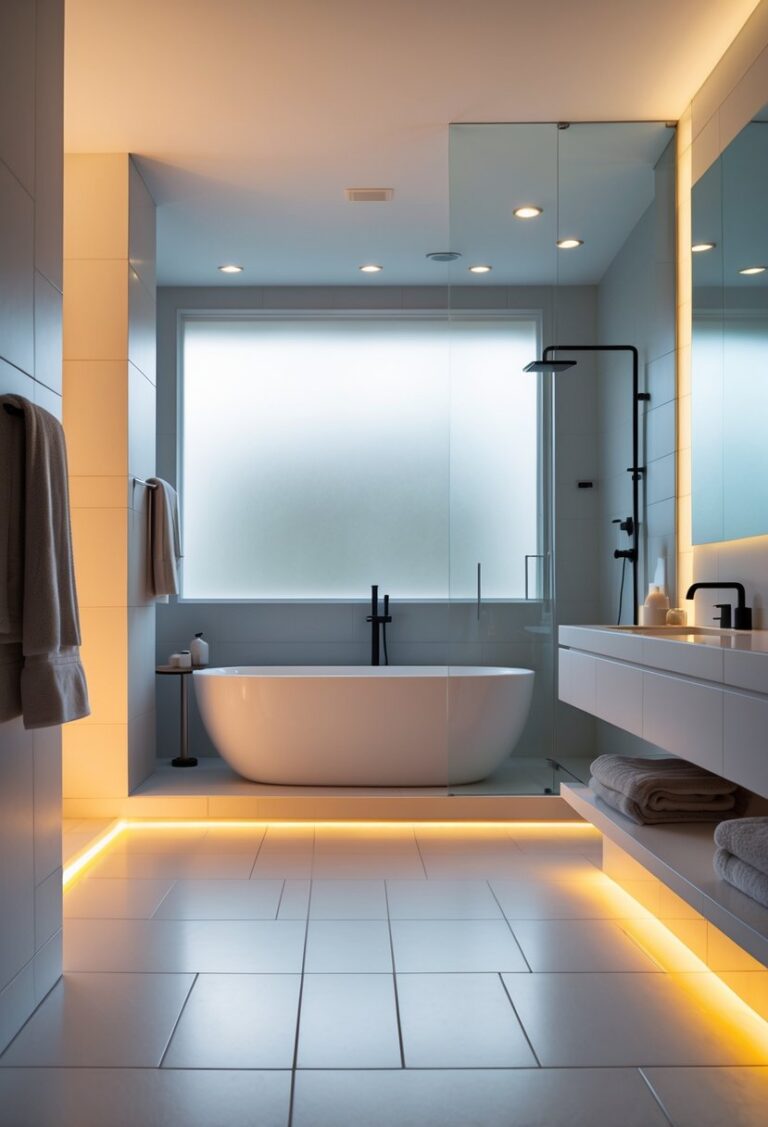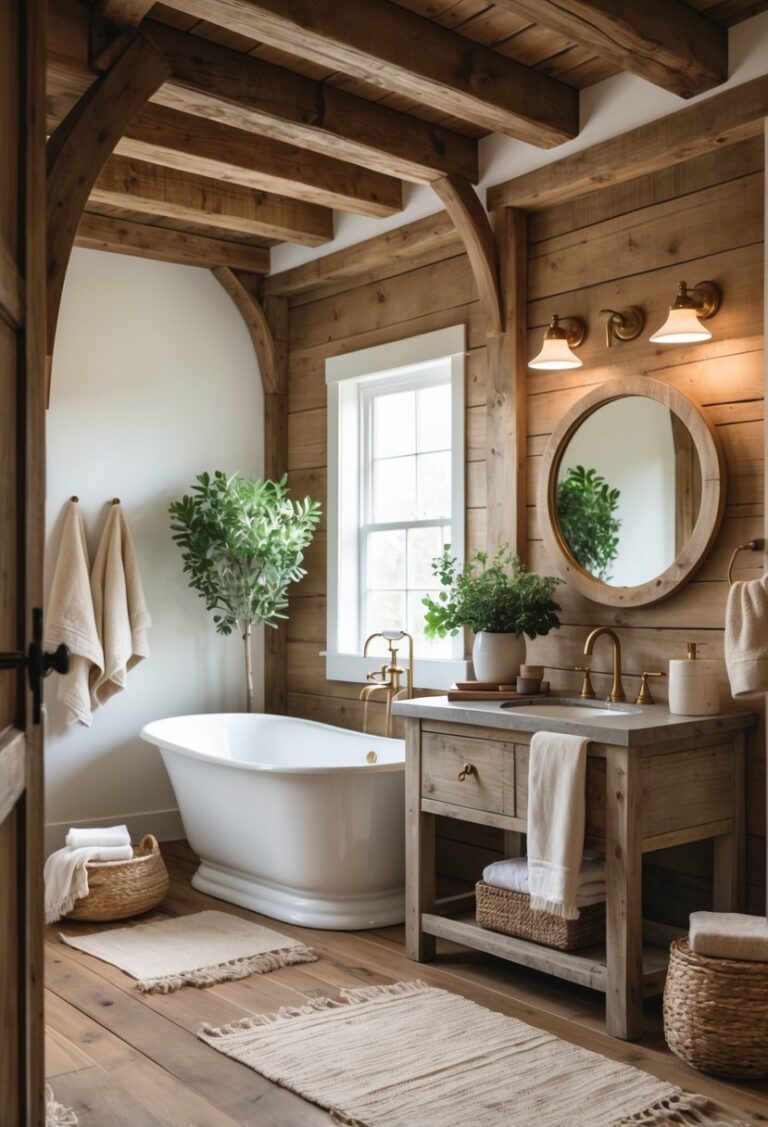25+ Japandi Bathroom Ideas for a Calm, Minimalist Retreat
Japandi style combines the serene simplicity of Japanese design with the cozy warmth of Scandinavian interiors. This fusion creates peaceful spaces, and the bathroom is the perfect place to apply this tranquil aesthetic. By blending natural materials, clean lines, and minimalist design, a Japandi bathroom fosters an atmosphere of calm and relaxation. Below, we’ll explore 25+ elements that can transform your bathroom into a Japandi-inspired retreat.

What Is Japandi Style?
Japandi is a design style that fuses Japanese minimalism with Scandinavian functionality and warmth. It emphasizes simplicity, clean lines, and natural materials, creating a calm and harmonious space. In the bathroom, this style typically incorporates neutral colors, natural wood elements, and a focus on both form and function. The overall aesthetic is uncluttered, welcoming, and perfect for creating a sanctuary.

Wood Slat Walls:
Wood slat walls are an essential feature of Japandi bathroom designs, offering a sleek yet warm element. The wooden slats bring texture to the room while maintaining a minimalist appeal. These walls often serve as both an aesthetic and functional choice, adding a natural touch without overwhelming the space. They help create a soothing atmosphere ideal for a spa-like experience.

Natural Greenery:
Adding plants is a key feature of Japandi style, with natural greenery offering life and color to the space. Plants like ferns, bamboo, or succulents are perfect for Japandi bathrooms. They not only enhance the natural theme but also improve air quality, making the space feel fresher and more inviting. Incorporating greenery creates a peaceful connection to nature.

Wood Cabinetry:
Wood cabinetry is a staple in Japandi bathrooms, as it combines both functionality and beauty. The use of light or medium-tone wood adds a touch of warmth while maintaining a clean, minimalist look. Whether it’s a floating vanity or built-in shelving, wood cabinetry offers practical storage solutions while contributing to the calm, grounded aesthetic of Japandi style.

Natural Light:
Japandi bathrooms embrace natural light to create a bright, airy atmosphere. Large windows, skylights, or light-filtering shades allow sunlight to pour in, adding warmth and creating a more open space. Natural light highlights the beauty of wood, stone, and other natural materials, enhancing the serene and welcoming feel of the room.

Wood-Clad Mirror Niche:
A wood-clad mirror niche adds a unique and functional touch to your Japandi bathroom. The warm wood tones surrounding the mirror create a harmonious focal point while offering storage for bathroom essentials. This design feature blends form with function, keeping the space tidy and visually appealing.

Stone Tile Walls:
Stone tile walls bring an earthy, grounded feel to Japandi bathrooms. Natural stone tiles, like slate or limestone, add texture and depth, enhancing the minimalist design. The use of stone echoes the Japanese tradition of connecting with nature and creates a luxurious, spa-like atmosphere.

Washi Paper Ceiling Light:
Washi paper ceiling lights are a perfect example of Japandi’s Japanese influence. These lights provide a soft, diffused glow that creates a calm, tranquil environment. The handmade texture of washi paper adds an artistic touch, making the light fixture a key design element in your bathroom’s serene space.

Mixed Wood Tones:
Mixing different wood tones creates visual interest and warmth while maintaining the balanced simplicity of Japandi style. You might see dark wood for flooring combined with lighter wood for cabinetry or accent pieces. This combination adds dimension and texture without overwhelming the space.

Japanese Art:
Incorporating Japanese art into your bathroom design is a subtle way to embrace Japandi aesthetics. Traditional pieces, such as sumi-e (Japanese ink painting) or minimalist calligraphy, can add depth and a sense of calm. Art in a Japandi bathroom should be simple, understated, and complement the overall design of the space.

Wooden Bathtub:
A wooden bathtub, often crafted from hinoki wood, is a striking element in Japandi bathrooms. Not only does it provide a luxurious and relaxing experience, but it also aligns with the natural, organic materials central to Japandi style. The unique grain of the wood adds character, while the material itself enhances the earthy ambiance.

White Pebble Floor:
White pebble floors offer a unique textural contrast in Japandi bathrooms. These small, smooth stones provide a tactile, calming experience underfoot. A pebble floor adds a natural, organic element to the design, complementing other materials like wood and stone.

Black Pebble Flooring:
Black pebble flooring offers a deeper, more dramatic alternative to white pebbles. It introduces a sleek, sophisticated vibe while maintaining the natural elements essential to Japandi style. The dark tones of black pebbles create a striking contrast with lighter wood or stone accents.

Textured Backsplash:
A textured backsplash in a Japandi bathroom can be made from materials like natural stone or textured ceramic tiles. These backsplashes provide visual interest without detracting from the minimalist aesthetic. Subtle textures create a sense of depth and warmth, enhancing the room’s overall tranquility.

Natural Wood Doors:
Natural wood doors contribute to the Japandi bathroom’s seamless flow of organic materials. The doors can be left in their natural state or stained to achieve a more polished look. These doors create a serene, welcoming entryway, aligning with the overall peaceful ambiance of Japandi design.

Natural Textiles:
Natural textiles, such as cotton, linen, and bamboo, play an important role in Japandi bathrooms. Towels, bath mats, and shower curtains made from organic materials promote a sense of simplicity and calm. The use of these textiles complements the warm wood elements and enhances the earthy, nature-inspired aesthetic.

Faux Wood Tiles:
Faux wood tiles are a practical alternative to real wood flooring, offering the same aesthetic benefits without the maintenance. These tiles mimic the look of natural wood, providing the same warmth and texture that define Japandi style. Faux wood tiles are durable, easy to maintain, and perfect for bathrooms that need moisture-resistant materials.

Wood and Stone:
A combination of wood and stone is quintessential to Japandi bathroom design. These materials create a balanced, harmonious environment that feels grounded and tranquil. Whether through wood accents paired with stone walls or a stone sink set against a wooden vanity, this combination fosters a connection to nature.

Integrated Lighting:
Integrated lighting in Japandi bathrooms provides both function and style. Recessed lights, hidden LED strips, and ambient lighting fixtures allow for soft, even illumination that enhances the tranquil atmosphere. Proper lighting is key to showcasing the natural materials and clean lines central to Japandi design.

Built-In Storage:
Built-in storage is essential for maintaining the clean, uncluttered appearance of a Japandi bathroom. Custom cabinetry, floating shelves, or recessed niches provide functional solutions while maintaining the bathroom’s minimalist aesthetic. These storage options help keep the space organized and serene.

Wood-Clad Ceiling:
A wood-clad ceiling adds warmth and texture to Japandi bathrooms. By using natural wood, you create a ceiling that ties the room together while enhancing the cozy, organic atmosphere. This feature is particularly effective in bathrooms with high ceilings, where the wood helps to bring balance to the space.

Wood Accent Wall:
A wood accent wall can be used to highlight a particular area of your Japandi bathroom, such as behind the vanity or around the bathtub. The natural wood grain adds visual interest and texture, creating a focal point that doesn’t overwhelm the space.

Dominant Stone:
Dominant stone features in Japandi bathrooms can include large stone sinks, stone bathtubs, or accent walls. Stone creates a strong, grounding presence and enhances the bathroom’s connection to nature. Its raw, organic beauty complements the minimalist wooden elements typical of Japandi style.

Leather Cabinet Pulls:
Leather cabinet pulls add a touch of elegance and sophistication to Japandi bathrooms. The rich texture of leather contrasts nicely with wood and stone, offering a tactile element that elevates the overall design. Leather pulls are subtle but impactful, contributing to the organic, warm vibe of the space.

Earth Tone Tiles:
Earth tone tiles, such as beige, taupe, and terracotta, are commonly used in Japandi bathrooms. These colors complement wood tones and natural stone, creating a balanced and calm environment. Earth tones evoke feelings of warmth and relaxation, making them perfect for a bathroom retreat.

Wood-Look Shower Tiles:
Wood-look shower tiles provide the aesthetic of wood while offering the durability and water resistance of ceramic or porcelain. These tiles are perfect for creating a cohesive Japandi bathroom look, maintaining the connection to nature while ensuring practicality in wet environments.

What’s The Difference Between a Japanese-Style Bathroom and a Traditional American Bathroom?
A Japanese-style bathroom is known for its focus on serenity, minimalism, and practicality. It often includes features like deep soaking tubs, natural materials, and separate spaces for bathing and toilet use. In contrast, a traditional American bathroom typically prioritizes convenience and efficiency, often with a focus on multi-use fixtures and a more cluttered aesthetic.

What’s the Difference Between a Japandi Bathroom and a Wabi-Sabi Bathroom?
While both Japandi and wabi-sabi styles embrace simplicity and natural materials, wabi-sabi celebrates imperfection, asymmetry, and the beauty of aging. Japandi, on the other hand, blends clean, modern lines with natural elements, creating a balance between functionality and warmth. A Japandi bathroom tends to feel more polished, whereas a wabi-sabi bathroom leans into a more rustic, lived-in charm.








